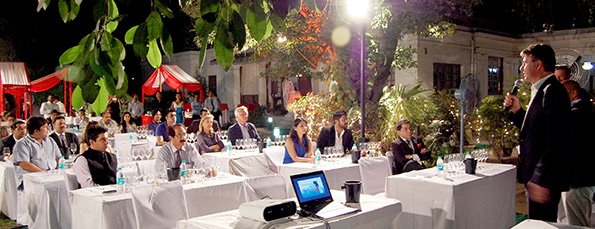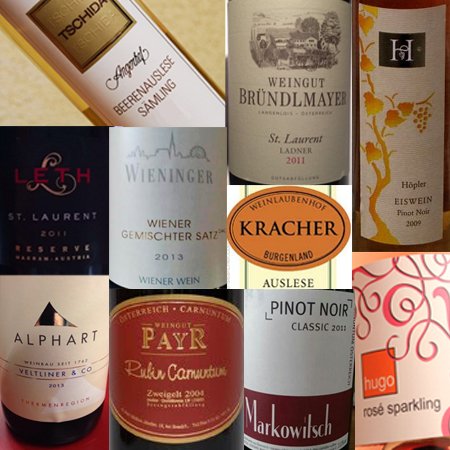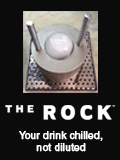|
|||||||||||||
|
|||||||||||||
| Mastering Austrian Class | |||||||||||||
| By Ravi Joshi | |||||||||||||
| Austria is an "old world" wine producing nation and history of winemaking goes back to the 5th century. Geographically, Austria is blessed to be in the ideal conditions for wine-making band of latitude 30 – 50 degrees. However, Austria is at a disadvantage with regard to the connaissance of its wines, specially in India. | |||||||||||||
 |
|||||||||||||
Ambassador Bernhard Wrabetz at the Masterclass |
|||||||||||||
| To plan, implement and exploit – these were probably the under-lying tenets that guided the Austrian Wine Marketing Board to host a trilogy of Master classes and wine tastings with the Austrian Trade Commission in New Delhi in 2014. | |||||||||||||
| The ‘master classes’ presented a holistic coverage of the Austrian wine milieu to improve the understanding of these wines and were spread over a period of 8 months – they were held in April, September and November – at the Austrian Trade Commissioner’s residence in Lutyens' Delhi. | |||||||||||||
| I present all three, and look at them one-by-one: | |||||||||||||
 |
|||||||||||||
The stand-out wines at the master classes |
|||||||||||||
| Master class # 1 | |||||||||||||
| Aim: Introduction of wines from different regions of Austria | |||||||||||||
| Wine statistics: 58 wines from 13 wineries. 14 wines in the masterclass, the rest were available at the walk-around tasting. | |||||||||||||
| Flying in from Austria: Rudolf Trischler from Sunny Grapes, the marketing agency for the wines represented. | |||||||||||||
| Conducted by: Magandeep Singh | |||||||||||||
| About the session: An emphasis on the terroir, typical grape varietals and pronunciation. Departing from the conventional ‘Whites first, Reds after’, the wines were presented region-wise. This allowed a better understanding of the Loess (calcerous clay and silt soil with fossil fragments) influenced minerally wines from Lower Austria and the ripe full bodied reds as well as the noble rot driven sweet wines from the sunny and marshy Burgenland. | |||||||||||||
| Wines that stood out: | |||||||||||||
| Alphart Rotgipfler vom Berg 2013 (Thermenregion, Lower Austria). Crystal clear, light gold wine with fruity and spicy aromas. A dry, light bodied palate with mouth watering acidity but appreciable balance. | |||||||||||||
| Payr Zweigelt Rubin 2012 (Carnuntum, Lower Austria). A luminescent ruby wine with aromas of wild berries and oak. A dry and medium bodied palate having good structure, replete with flavours of red fruits and spice. | |||||||||||||
| Höpler Eiswein Pinot Noir 2009 (Burgenland). A well-balanced wine having a floral, honeyed and nutty nose complemented by an explosively fruity palate and a lingering finish. | |||||||||||||
| Master class # 2 | |||||||||||||
| Aim: Showcasing the entire Austrian quality pyramid | |||||||||||||
| Wine statistics: 81 wines from 12 wineries. 17 wines in the masterclass, the rest were available at the walk-around tasting. | |||||||||||||
| Flying in from Austria: Christian Dworan, Marketing Manager from the Austrian Wine Marketing Board | |||||||||||||
| Conducted by: Gurjit Singh Barry | |||||||||||||
| About the session: The wines presented a good mix of international as well as Austrian native varietals. The aim of showcasing the Austrian wine classification system was well served by enabling sampling in a vertical graduation of the quality pyramid starting from a Kabinett, Spätlese and finishing with a Trockenbeerenauslese. | |||||||||||||
| Wines that stood out: | |||||||||||||
| Wieninger Wiener Gemischter Satz 2013 (white). ‘Wiener’ indicates a wine from Vienna, and Gemischter Satz is the term used for a wine made from a mix of varietals from the same plot. The wine had unmistakable aromas of tropical fruits (most prominent being lychee) and a well balanced palate with ripe fruity flavours. | |||||||||||||
| Weingut Bründlmayer St. Laurent Ried Ladner 2011 (red). St Laurent is a varietal typical to Austria and is quite close in characteristics to the Pinot Noir. An easy drinking wine with rounded tannins accompanied by aromas and flavours of raspberries and plums. | |||||||||||||
| Kracher Cuvée Auslese 2012 (sweet). Auslese defines wine quality literally meaning ‘select harvest’. A blend of Chardonnay and Welschriesling, this wine had floral and tropical fruit aromas. The palate was well balanced with flavours of quince, melon and white pepper. | |||||||||||||
| Master class # 3 | |||||||||||||
| Aim: Summing up the three master classes and highlighting DAC (Districtus Austriae Controllatus) | |||||||||||||
| Wine statistics: 63 wines from 8 wineries. 17 wines in the masterclass, the rest were available at the walk-around tasting. | |||||||||||||
| Flying in from Austria: Michael Thurner, former Director of the Austrian Wine Marketing Board could not arrive from Singapore due to a cancelled flight. Represented by the Austrian Trade Commissioner, Dr Wolfram Moritz. | |||||||||||||
| Conducted by: Magandeep Singh | |||||||||||||
| About the session: A diverse range of wines were included in the familiar but fine tuned format. The highlight of the session was a deep insight into the DAC – the specified quality wines producing regions of Austria, similar to the French AOC (Appellation d’Origine Contrôlée). Austria has eight specific districts that permit wine to be produced only from the specified varietal(s). These are: | |||||||||||||
| 1. Eisenberg (Bläufrankisch) 2. Kamptal (Grüner Veltliner, Riesling) 3. Kremstal (Grüner Veltliner, Riesling) 4. Leithaberg (Grüner Veltliner, Weissburgunder, Chardonnay, Neuberger, Bläufrankisch) 5. Mittelburgenland (Bläufrankisch) 6. Neusiedlersee (Zweigelt) 7. Traisental (Grüner Veltliner, Riesling) 8. Weinviertel (Grüner Veltliner) |
|||||||||||||
| I was able to evaluate similar wines from different regions, draw comparisons between native Austrian and international varietals and taste wine verticals from the same winery. A dégustation menu by the Lemon Tree, Delhi kept the wines in good company. | |||||||||||||
| Wines that stood out: | |||||||||||||
| Huber Rosé Sparkling HUGO (Traisental, Lower Austria). A blend of Zweigelt and Pinot Noir, this was an Extra Dry (12-20 gms per litre residual sugar) lightly sparkling wine with a palate of intense red fruit. A good wine for brunches. | |||||||||||||
| Markowitsch Pinot Noir 2011 (Carnuntum, Lower Austria). A pleasant and lusciously fruity Pinot Noir with light tannins going from fiber to steel as it progressed to finish. An easy drinking wine as well as food friendly. | |||||||||||||
| Leth St. Laurent Reserve 2011 (Wagram, Lower Austria). A wine that was very well received by the audience. An excellent structure and an indulgent mouthfeel. In the classical sense, it qualified as ‘an iron fist in a velvet glove’ | |||||||||||||
| Angerhof-Tschida Sämling 88 Beerenauslese 2012 (Neusiedlersee, Burgenland). A wine with good acidity and sugar balance, a trait that is critical for good sweet wines. Aromas of ripe peaches, bay leaf, fruit jam and flavours of quince, honey and white pepper. | |||||||||||||
| The Results | |||||||||||||
| In conclusion, did the trilogy of master classes yield desirable results? Dr. Wolfram Moritz, Trade Commissioner & Commercial Counsellor at the Austrian Embassy in New Delhi, believes that they did. The response has been extremely positive and encouraging. “Through these events, a wide range of Austrian wines – white, red and sweet – were introduced to the relevant people in the wine business, who were pleasantly surprised with the quality of Austrian wines. We received a lot of commercial queries on bringing these wines to the market”, elaborated Dr. Moritz. | |||||||||||||
| The same sentiment is echoed by Christian Dworan, who feels that the primary aim of the AWMB to connect with a lot of enthusiastic wine people and wine specialists in India was well served with these master classes. The elements of uniqueness (climate, land, grapes, culture, people & nature, value for money, food pairing) for Austrian Wine were highlighted. Mr. Dworan is also pleased with the ‘media echo’ of these events that have created the right atmosphere for awareness on Austrian wines in India. | |||||||||||||
| Next Steps | |||||||||||||
| Mr. Dworan shared with me that in 2015, the Austrian Wine Marketing Board would monitor the market closely to consolidate the gains already made. Dr. Moritz hopes to see more Austrian wines available in the Indian market in the near future, despite the cumbersome tax regime. The Austrian Trade Commission plans a series of smaller events to promote Austrian wines. | |||||||||||||
| The Austrians are clearly in the "Exploit" phase. In the interest of getting more opportunities to explore these fascinating wines, I wish them well. | |||||||||||||
|
|||||||||||||
|
|||||||||||||











